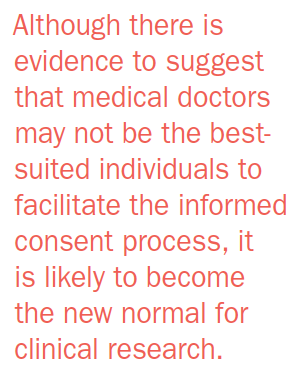How Does Shinal v. Toms Affect Informed Consent in Pennsylvania Clinical Trials?
Applied Clinical Trials
The ruling by the Pennsylvania Supreme Court requiring informed consent to be obtained by a medical doctor could set a precedent for future nationwide cases involving clinical research.
The recent court case Shinal v. Toms involved a woman undergoing surgery to treat a benign brain tumor growing near the patient’s pituitary gland.1 After discussing treatment options with Dr. Toms, then a neurosurgeon at Geisinger Medical Center’s neurosurgery clinic, Mrs. Shinal spoke over the phone with Dr. Tom’s assistant. The treating physician’s assistant obtained an informed consent form from Mrs. Shinal prior to surgery. During surgery, Mrs. Shinal suffered permanent injury from complications and sued the physician, alleging his failure to explain the risks of and alternatives to her surgery.
Until Shinal v. Toms, physicians interpreted the duty to obtain informed consent as one that could be delegated to a qualified staff member, and to include talking with the patient, discussing an overview of the procedure in question, and ultimately obtaining the patient’s informed consent. However, in Shinal v. Toms, the Pennsylvania Supreme Court found that effective informed consent stems from the contractual nature of the physician-patient relationship and, consequently, necessitated a “meeting of the minds” between the parties, which could only occur by a physical interaction between the doctor and patient.2 In support of its holding, the court quoted Kelly v. Methodist Hospital, noting that the physician’s unique relationship with the patient, as well as the physician’s education and training, mean that “the physician is in the best position to know the patient’s medical history and to evaluate and explain the risks of a particular operation in light of the particular medical history.”3
Further, the physician has a duty to disclose these risks to the patient.4 Consequently, the court held that the duty to provide informed consent belonged to the physician alone and was non-delegable, because “obtaining informed consent results directly from the duty of disclosure, which lies solely with the physician.”5 Although the ruling is binding only in Pennsylvania, physicians in other states should note that their state may take a similar view of informed consent.
What this means for informed consent in investigational research in Pennsylvania
The Pennsylvania Supreme Court has taken a more conservative view of who may obtain informed consent than FDA guidelines imply. The FDA says that informed consent must be obtained by an “investigator.” The agency does clarify, however, that the investigator need not be a medical doctor and that a “physician can be a subinvestigator to perform those study functions requiring the appropriate level of medical expertise.”6 This suggests a great deal of flexibility in federal regulations and their interpretation as to who may be considered a principal investigator or a subinvestigator, and also means that an individual who is not a physician may be delegated the primary responsibility to obtain a subject’s informed consent. In the context of clinical trials, this has traditionally been a study coordinator or a nurse. In Pennsylvania, Shinal v. Toms has restricted this view of informed consent considerably.
Failure to obtain sufficient informed consent is already the subject of many malpractice lawsuits, and the Shinal v. Toms ruling may provide precedent for future cases involving clinical research.7 A prima facie interpretation of the court’s opinion suggests that informed consent by the physician is non-delegable.8 While this reading of the court’s opinion is not any more onerous than a strict reading of the regulations, which potentially require that only the principal investigator perform the informed consent interview, it does place an unexpected burden on clinical research facilities. In light of the ruling in Shinal vs. Toms, the informed consent process during clinical trials must be restructured to ensure that doctors are informing patients and obtaining consent.
Immediate impact
The court’s ruling has confused several clinical trial sites, each of whom are approaching this from a risk-based perspective. Informal, confidential discussions with multiple sites indicate that larger sites are adopting a “wait-and-see” approach, with several discussions taking place internally. These large sites may be enlisting the help of legal experts as they decide how to restructure a large organization to comply with the court’s opinion.
Conversely, we are currently unaware of smaller research sites who have changed their informed consenting procedures, and may currently be vulnerable from a risk-based perspective. Smaller sites may be waiting for a specific directive from the courts, or the FDA, before investing in any changes, leaving themselves vulnerable to lawsuits due to their smaller resource pool.
Some mid-sized sites, which typically have limited bureaucracies, are taking a different tack. They are proactively requiring that physicians obtain informed consent. Such mid-sized Pennsylvania-based hospitals have already begun changing their consenting procedures. In the near term, we expect the following:
- Lack of physician availability. Investigators are notoriously busy individuals,9 and without being allowed to delegate the informed consent process, their time is further strained. Pennsylvania sites which choose to amend their standard operating procedures (SOPs) will likely face delays in trial initiation as physicians strain to fit yet another task into an already tight schedule. Obtaining informed consent is not a one-time meeting, but rather a process. In order for each participant to receive the appropriate amount of attention and information, patient enrollment in clinical trials will take longer than before.
- SOP changes. Additionally, Pennsylvania-based clinical trial teams that choose to proactively require their physicians to obtain informed consent will now need to review-and potentially rewrite-their SOPs. This will be followed by additional training for physicians, as well as support staff, who will need to know what types of questions they can answer, and which must be deferred to the investigating physician. Furthermore, SOP revisions must go through a quality assurance analysis and potentially internal auditing before the procedures are adopted.
- Increased costs. Current trial budgets will be constrained as participant enrollment slows, and future trials will require more funding. This may impact trial scheduling as well, because sponsor organizations must plan their budgets to allow for greater costs of trial initiation. If the costs become too much, some sponsors may decide to leave Pennsylvania and conduct their trials in a state with less restrictive informed consent laws.
- Liability premiums. Additionally, such heightened levels of responsibility for the investigating physician would likely cause insurance companies to increase professional liability insurance premiums for physicians in the context of clinical research, thereby further increasing the costs of studies. As has happened with some specialties in medical practice, physicians may simply decide not to work in high-risk trials if the premiums become too expensive or unavailable.10 Again, this would strongly disincentivize sponsors from choosing to conduct trials in Pennsylvania.
Even as reactionary responses to the Shinal v. Toms case are being implemented in the Pennsylvania research settings, it is worth considering how physician-administered informed consent affects patient outcomes and if a prima facie reading of the court’s opinion is an accurate reading of the opinion itself.
Are doctors equipped to obtain consent?
A reasonable reading of the court’s opinion suggests that it intended that the most qualified person perform the consenting process. Medical doctors are not always the best-suited member of the investigation team to administer informed consent. Unfortunately, some medical doctors lack the time or the necessary communication skills to properly deliver non-clinical facts to the study participant. Moreover, financial considerations and study protocol requirements may not be the physician’s specific area of focus and may actually need to be explained by a study coordinator. Finally, the investigative team should consider each participant’s reasons for participating (or not), as well as their hopes for the outcome of the trial. Under the extreme time constraints that many physicians face, this important holistic piece of patient care is not likely to be a priority.
The Joint Commission notes that “[e]ven after signing a consent form, patients frequently do not understand the risks, benefits, and alternatives involved in their course of treatment or surgical procedure-all of which are imperative for a patient to provide valid authorization.”11 While a medical doctor is likely the best trained person to understand the risks and benefits as it applies to the clinical impact for a specific patient, he or she may not be the most skilled communicator on the team. Institutional review boards (IRBs), FDA, and patient advocacy groups should monitor how these changes affect the quality of informed consent in Pennsylvania’s clinical trials.
Addressing inadequate medical doctor-performed informed consent in clinical trials
If solely physician-obtained informed consent is the new standard, investigation teams seeking to uphold a high standard of care should consider using proven techniques to ensure that informed consent remains patient-centered. Although these extra steps will cost the investigative team time, it will improve patient understanding of the risks and benefits. In a study comparing patient understanding of procedural risks following a physician

informed consent meeting with and without a follow-up phone call from a nurse, the patients who received the phone call reported better subjective understanding of the material.12 However, as was seen in Shinal v. Toms, physicians must be sure to obtain consent again after any new information is presented.
Changes in patient expectations
Clinical research teams must take into account how the changes in the informed consent process will affect patient expectations. If the physician is the initial point of contact for the patient through the informed consent process, the patient may expect that the doctor is the primary point of contact for future interactions as well. This is impractical for the physician, and a poor use of resources within the research team. Clinical research coordinators or nurses may need to take extra steps to build the relationship with the patient that would have otherwise started during the informed consent process, relieving some of the patient interaction from the investigator.
Conclusions
The case of Shinal vs. Toms is placing an unexpected burden on many of Pennsylvania’s clinical research sites, who are putting together new procedures in order to comply with the court’s opinion. Although there is evidence to suggest that medical doctors may not be the best-suited individuals to facilitate the informed consent process, it is likely to become the new normal for clinical research. Investigative teams must consider ways in which they can improve the informed consent process while working within the narrow framework established by Shinal v. Toms.



Darshan Kulkarni, PharmD, MS, Esq, is the Principal Attorney at The Kulkarni Law Firm and a member of Applied Clinical Trials' Editorial Advisory Board; Andrea Tunnard is an MS candidate in the Biomedical Writing program at University of the Sciences; and Erin Grant is a JD/MHA candidate at Saint Louis University
References
1. Shinal v. Toms, No. 31 MAP 2016, 2017 WL 2655387, at *2, *14 (Pa. 2017).
2. Gray v. Grunnagle, 223 A.2d 663, 674 (Pa. 1966).
3. Kelly v. Methodist Hosp., 664 A.2d 148, 151 (Pa. Super. 1995).
4 Shinal, 2017 WL 2655387, at *16.
5 Id.
6. Cynthia F. Kleppinger, U.S. Food & Drug Admin., Division of Good Clinical Practice Compliance, Presentation at the FDA 2013 Clinical Investigator Training Course: Investigator Responsibilities – Regulation and Clinical Trials (Nov. 13, 2013), https://www.fda.gov/downloads/training/clinicalinvestigatortrainingcourse/ucm378565.pdf.
7. Preventing Informed Consent Malpractice Claims. By Joan M. Roediger, JD, LLM & Gary M. Samms, Esq.
8. Shinal v. Toms, No. 31 MAP 2016, 2017 WL 2655387, at *2, *14 (Pa. 2017).
9. Surgeons work an average of 50-60 hours per week, not including time spent on call. Surgical Career Lifestyle Issues, Am. Coll. Surgeons, https://www.facs.org/education/resources/medical-students/lifestyle (last visited July 29, 2017).
10. Gorman T. Physicians fold under malpractice fee burden. Los Angeles Times. March 04, 2002. Available from: http://articles.latimes.com/2002/mar/04/news/mn-31012. Accessed Nov 12, 2017.
11. Informed Consent: More Than Getting a Signature. Joint Commission, Division on Healthcare Improvement 1 (Feb. 2016).
12. Aaronson NK, Visser-Pol E, Leenhouts GH, et al. Telephone-based nursing intervention improves the effectiveness of the informed consent process in cancer clinical trials. JCO. 1996;14(3):984-996. http://ascopubs.org/doi/abs/10.1200/jco.1996.14.3.984. Accessed Nov 12, 2017.
